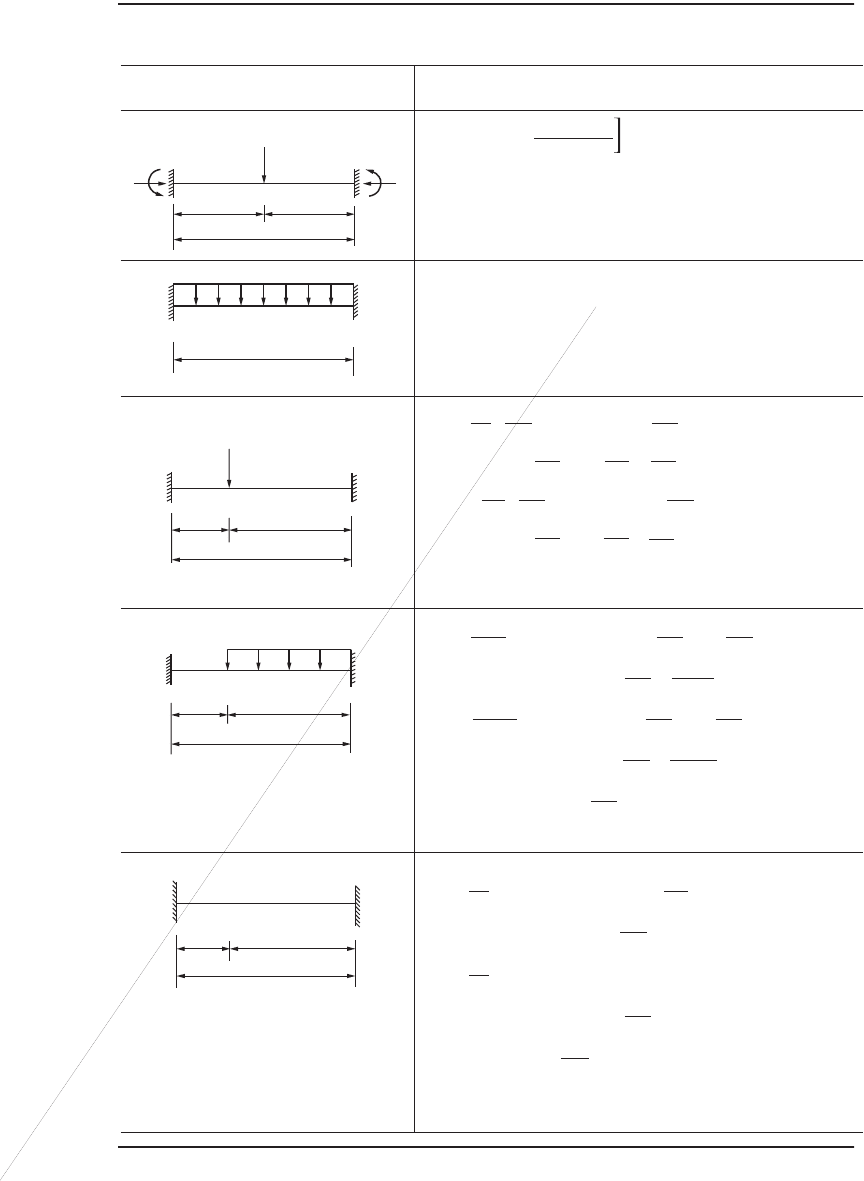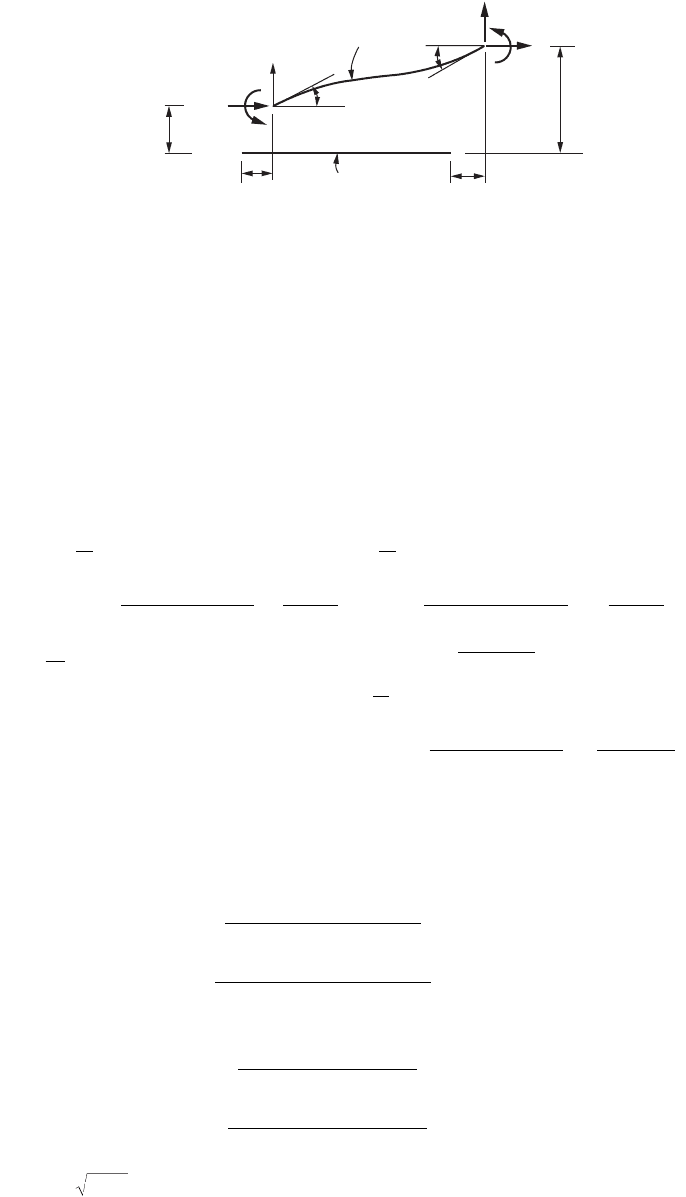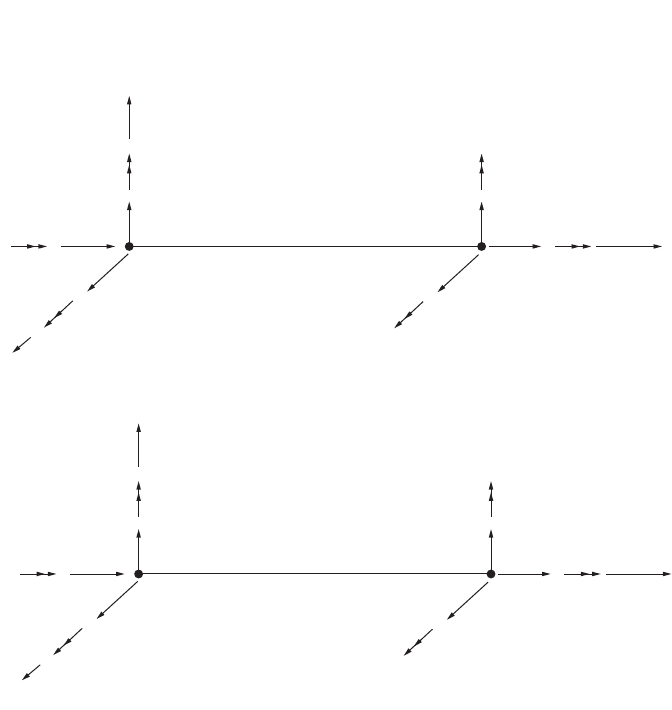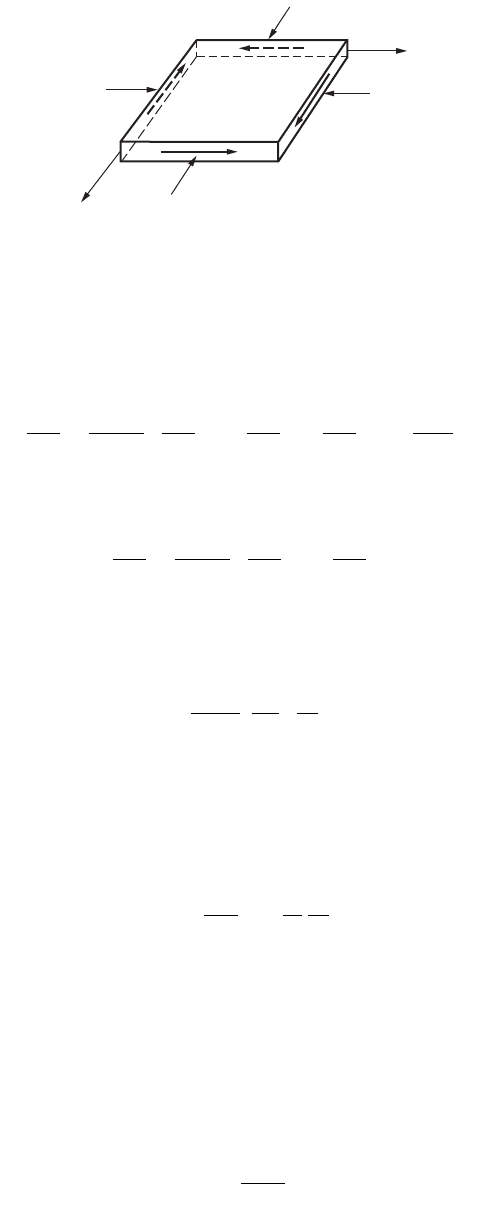Wai-Fah Chen.The Civil Engineering Handbook
Подождите немного. Документ загружается.


Theory and Analysis of Structures 47-151
TA B L E 47.4 Beam-Column Fixed-End Moments (Chen and Lui, 1991)
M
FB =
−
8u
w
2
L
e
2
(2u cot 2u − 1 )
2u
L
b
− sin
2u
L
b
where
+ (tan u) 1 − cos
2u
L
b
−
2u
L
2
2
b
2
+ (tan u) 1 − cos
2u
L
b
+
2u
L
2
2
b
2
− 2u 1 − cos
2u
L
b
− (tan u) 1 − cos
2u
L
b
− (tan u) 1 + cos
2u
L
b
+ 2u cos
2u
L
b
M
FA
=
Q
d
L 2u
L
b
cos 2u − 2u cos
2u
L
b
− sin 2u
+
sin
2u
L
a
+ sin
2u
L
b
+
2u
L
a
M
FB
= −
Q
d
L 2u
L
a
cos 2u − 2u cos
2u
L
a
− sin 2u
+
sin
2u
L
b
+ sin
2u
L
a
+
2u
L
b
where
d = 2u(2 − 2 cos 2u − 2u sin 2u)
M
FB
= −M
FA
M
FB
= −M
FA
M
FA
=
Q
8
L
2(1 − cos u)
u sin u

47-152 The Civil Engineering Handbook, Second Edition
For either of these approaches, the linearized element stiffness equations may be expressed in either
incremental or total force and displacement forms as
(47.328)
where [K] is the element stiffness matrix, {d} = {d
1
, d
2
, … , d
6
}
T
is the element nodal displacement vector,
{r
f
} = {r
f1
, r
f2
, … , r
f6
}
T
is the element fixed-end force vector due to the presence of in-span loading, and
{r} = {r
1
, r
2
, … , r
6
}
T
is the nodal force vector, as shown in Fig. 47.122. If stability function approach is
employed, the stiffness matrix of a two-dimensional beam-column element may be written as
(47.329)
where S
ii
and S
ij
are the member stiffness coefficients obtained from the elastic beam-column stability
functions (Chen and Lui, 1987). These coefficients may be expressed as
(47.330)
(47.331)
where kL = L and P is positive in compression and negative in tension.
FIGURE 47.122 Nodal displacements and forces of a beam-column element.
d
2
r
3
d
3
d
6
r
5
r
6
r
4
d
5
d
4
r
2
d
1
r
1
original position
deflected position
Kd r r
f
[]
{}
+
{}
=
{}
K
EI
L
A
I
A
I
SS kL
L
SS
L
SS kL
L
SS
L
S
SS
L
S
A
I
SS kL
L
SS
L
sym S
ii ij
ii ij
ii ij
ii ij
ii
ii ij
ij
ii ij ii ij
ii
[]
=
-
+
()
-
()
+
-+
()
+
()
+
-+
+
()
-
()
-+
()
È
Î
Í
Í
Í
Í
Í
Í
Í
Í
Í
00 0 0
2
0
2
0
00
2
2
2
2
2
2
2
()
.
ÍÍ
Í
Í
Í
˘
˚
˙
˙
˙
˙
˙
˙
˙
˙
˙
˙
˙
˙
˙
S
kL kL kL kL
kL kL kL
kL kL kL kL
kL kL kL
for P
for P
ii
=
()
-
() ()
-
()
-
()
() ()
-
()
-
()
+
()
Ï
Ì
Ô
Ô
Ó
Ô
Ô
<
>
sin cos
cos sin
cosh sinh
cosh sinh
2
2
22
22
0
0
S
kL kL kL
kL kL
kL kL kL
kL kL
for P
for P
ij
=
()
-
()
-
()
-
()
()
-
()
-
()
+
()
Ï
Ì
Ô
Ô
Ó
Ô
Ô
<
>
2
2
22
22
0
0
sin
cos sin
sinh
cosh sinh
r
r
PEI/
© 2003 by CRC Press LLC

Theory and Analysis of Structures 47-153
The fixed-end force vector r
f
is a 6 ¥ 1 matrix that can be computed from the in-span loading in the
beam-column. If curvature shortening is ignored, r
f1
= r
f4
= 0, r
f3
= M
FA
, and r
f6
= M
FB
. M
FA
and M
FB
can
be obtained from Table 47.4 for different in-span loading conditions. r
f2
and r
f5
can be obtained from
the equilibrium of forces.
If the axial force in the member is small, Eq. (47.329) can be simplified by ignoring the higher order
terms of the power series expansion of the trigonometric functions. The resulting element stiffness matrix
becomes:
(47.332)
The first term on the right is the first-order elastic stiffness matrix, and the second term is the geometric
stiffness matrix, which accounts for the effect of axial force on the bending stiffness of the member.
Detailed discussions on the limitation of the geometric stiffness approach versus the stability function
approach are given in Liew et al. (2000).
Modifications to Account for Plastic Hinge Effects
There are two commonly used approaches for representing plastic hinge behavior in a second-order
elastic-plastic hinge formulation (Chen et al., 1996). The most basic approach is to model the plastic
hinge behavior as a “real” hinge for the purpose of calculating the element stiffness. The change in
moment capacity due to the change in axial force can be accommodated directly in the numerical
formulation. The change in moment is determined in the force recovery at each solution step such that,
for continued plastic loading, the new force point is positioned at the strength surface at the current
value of the axial force. A detailed description of these procedures is given by Chen and Lui (1991), Chen
et al. (1996), and Lee and Basu (1989), among others.
Alternatively, the elastic-plastic hinge model may be formulated based on the “extending and contract-
ing” plastic hinge model. The plastic hinge can rotate and extend or contract for plastic loading and axial
force. The formulation can follow the force–space plasticity concept using the normality flow rule relative
to the cross section surface strength (Chen and Han, 1988). Formal derivations of the beam-column
element based on this approach have been presented by Porter and Powell (1971), Orbison et al. (1982),
and Liew et al., (2000), among others.
Modification for End Connections
The moment rotation relationship of the beam-column with end connections at both ends can be
expressed as (Eqs. (47.317) and (47.318)):
(47.333)
(47.334)
K
EI
L
A
I
A
I
LL LL
L
A
I
LL
sym
P
LL
LL
L
sym
[]
=
-
-
-
-
È
Î
Í
Í
Í
Í
Í
Í
Í
Í
Í
Í
Í
Í
˘
˚
˙
˙
˙
˙
˙
˙
˙
˙
˙
˙
˙
˙
+
-
--
-
00 00
12 6
0
12 6
40
6
2
00
12 6
4
00 0 00 0
6
5
1
10
0
6
5
1
10
2
15
0
1
10 30
00 0
6
5
1
10
2
22
2
.
.
LL
15
È
Î
Í
Í
Í
Í
Í
Í
Í
Í
Í
Í
˘
˚
˙
˙
˙
˙
˙
˙
˙
˙
˙
˙
M
EI
L
ss
AiiAij B
=+
[]
**
qq
M
EI
L
ss
BijAjj B
=+
[]
**
qq
© 2003 by CRC Press LLC

47-154 The Civil Engineering Handbook, Second Edition
where
(47.335)
(47.336)
and
(47.337)
The member stiffness relationship can be written in terms of six degrees of freedom — see the beam-
column element shown in Fig. 47.123 — as
Second-Order Refined Plastic Hinge Analysis
The main limitation of the conventional elastic-plastic hinge approach is that it overpredicts the strength
of columns that fail by inelastic flexural buckling. The key reason for this limitation is the modeling of
FIGURE 47.123 Nodal displacements and forces of a beam-column with end connections.
r
1
, d
1
r
2
, d
2
r
5
, d
5
r
6
, d
6
r
4
, d
4
r
3
, d
3
L
EI = constant
∆
S
S
EIS
LR
EIS
LR
EIS
LR
EIS
LR
EI
L
S
RR
ii
ii
ii
kB
ij
kB
ii
kA
jj
kB
ij
kA kB
*
=
+-
+
È
Î
Í
˘
˚
˙
+
È
Î
Í
˘
˚
˙
-
È
Î
Í
˘
˚
˙
2
2
2
2
11
S
S
EIS
LR
EIS
LR
EIS
LR
EIS
LR
EI
L
S
RR
jj
ii
ii
kA
ij
kA
ii
kA
jj
kB
ij
kA kB
*
=
+-
+
È
Î
Í
˘
˚
˙
+
È
Î
Í
˘
˚
˙
-
È
Î
Í
˘
˚
˙
2
2
2
2
11
S
S
EIS
LR
EIS
LR
EI
L
S
RR
ij
ij
ii
kA
jj
kB
ij
kA kB
*
=
+
È
Î
Í
˘
˚
˙
+
È
Î
Í
˘
˚
˙
-
È
Î
Í
˘
˚
˙
11
2
2
r
r
r
r
r
r
EI
L
A
I
A
I
SSSkL
L
SS
L
SSS kL
L
SS
L
S
SS
L
S
ii ij jj ii ij
ii ij jj
ij jj
ii
ii ij
1
2
3
4
5
6
2
2
2
2
00 0 0
2
0
2
0
Ê
Ë
Á
Á
Á
Á
Á
Á
Á
ˆ
¯
˜
˜
˜
˜
˜
˜
˜
=
-
++-
()
+
-+ +
()
+
()
+
-+
*** **
***
**
*
**
()
ijij
ii ij jj
ij jj
jj
A
I
SSSkL
L
SS
L
sym S
d
d
d
d
d
d
*
***
**
*
.
00
2
2
2
1
2
3
4
5
6
++-
()
-+
()
È
Î
Í
Í
Í
Í
Í
Í
Í
Í
Í
Í
Í
Í
Í
Í
˘
˚
˙
˙
˙
˙
˙
˙
˙
˙
˙
˙
˙
˙
˙
˙
Ê
Ë
Á
Á
Á
Á
Á
Á
Á
ˆ
¯
˜
˜
˜
˜
˜
˜
˜
(47.338)
© 2003 by CRC Press LLC
Theory and Analysis of Structures 47-155
a member by a perfect elastic element between the plastic hinge locations. Furthermore, the elastic-plastic
hinge model assumes that material behavior changes abruptly from the elastic state to the fully yielded
state. The element under consideration exhibits a sudden stiffness reduction upon the formation of a
plastic hinge. This approach, therefore, overestimates the stiffness of a member loaded into the inelastic
range (Liew et al., 1993; White et al., 1991, 1993). This leads to further research and development of an
alternative method called the refined plastic hinge approach. This approach is based on the following
improvements to the elastic-plastic hinge model:
1. A column tangent modulus model E
t
is used in place of the elastic modulus E to represent the
distributed plasticity along the length of a member due to axial force effects. The member inelastic
stiffness, represented by the member axial and bending rigidities E
t
A and E
t
I, is assumed to be the
function of axial load only. In other words, E
t
A and E
t
I can be thought of as the properties of an
effective core of the section, considering column action only. The tangent modulus captures the
effect of early yielding in the cross-section due to residual stresses, which is believed to be the
cause for the low strength of inelastic column buckling. The tangent modulus approach has been
previously utilized by Orbison et al. (1982), Liew (1992), and White et al. (1993) to improve the
accuracy of the elastic-plastic hinge approach for structures in which members are subjected to
large axial forces.
2. Distributed plasticity effects associated with flexure are captured by gradually degrading the
member stiffness at the plastic hinge locations as yielding progresses under an increasing load as
the cross section strength is approached. Several models of this type have been proposed in recent
literature based on extensions to the elastic-plastic hinge approach (Powell and Chen, 1986), as
well as the tangent modulus inelastic hinge approach (Liew et al., 1993; White et al., 1993). The
rationale of modeling stiffness degradation associated with both axial and flexural actions is that
the tangent modulus model represents the column strength behavior in the limit of pure axial
compression, and the plastic hinge stiffness degradation model represents the beam behavior in
pure bending; thus the combined effects of these two approaches should also satisfy the cases in
which the member is subjected to combined axial compression and bending.
It has been shown that with the above two improvements, the refined plastic hinge model can be used
with sufficient accuracy to provide a quantitative assessment of a member’s performance up to failure.
Detailed descriptions of the method and discussion of the results generated by the method are given in
White et al. (1993) and Chen et al. (1996). Significant work has been done to implement the refined
plastic hinge methods for the design of three-dimensional real-size structures (Al-Bermani et al., 1995;
Liew et al., 2000).
Second-Order Spread of Plasticity Analysis
Spread of plasticity analyses can be classified into two main types, namely three-dimensional shell element
and two-dimensional beam-column approaches. In the three-dimensional spread of plasticity analysis,
the structure is modeled using a large number of finite three-dimensional shell elements, and the elastic
constitutive matrix, in the usual incremental stress–strain relations, is replaced by an elastic-plastic
constitutive matrix once yielding is detected. This analysis approach typically requires numerical inte-
gration for the evaluation of the stiffness matrix. Based on a deformation theory of plasticity, the
combined effects of normal and shear stresses may be accounted for. The three-dimensional spread-of-
plasticity analysis is computational intensive and best suited for analyzing small-scale structures.
The second approach for plastic-zone analysis is based on use of the beam-column theory, in which
the member is discretized into many beam-column segments, and the cross section of each segment is
further subdivided into a number of fibers. Inelasticity is typically modeled by the consideration of
normal stress only. When the computed stresses at the centroid of any fibers reach the uniaxial normal
strength of the material, the fiber is considered yielded. Compatibility is treated by assuming that full
continuity is retained throughout the volume of the structure in the same manner as for elastic range
© 2003 by CRC Press LLC

47-156 The Civil Engineering Handbook, Second Edition
calculations. Most of the plastic-zone analysis methods developed are meant for planar (two-dimensional)
analysis (Chen and Toma, 1994; White, 1985; Vogel, 1985). Three-dimensional plastic-zone techniques
are also available involving various degrees of refinements (White, 1988; Wang, 1988).
A plastic-zone analysis, which includes the spread of plasticity, residual stresses, initial geometric
imperfections, and any other significant second-order behavioral effects, is often considered to be an
exact analysis method. Therefore, when this type of analysis is employed, the checking of member
interaction equations is not required. However, in reality, some significant behavioral effects, such as
joint and connection performances, tend to defy precise numerical and analytical modeling. In such
cases, a simpler method of analysis that adequately captures the inelastic behavior would be sufficient
for engineering application. Second-order plastic hinge-based analysis is still the preferred method for
advanced analysis of large-scale steel frames.
Three-Dimensional Frame Element
The two-dimensional beam-column formulation can be extended to a three-dimensional space frame
element by including additional terms due to shear force, bending moment, and torsion. The following
stiffness equation for a space frame element has been derived by Yang and Kuo (1994) by referring to
Fig. 47.124:
(47.339)
FIGURE 47.124 Three-dimensional frame element: (a) nodal degrees of freedom, (b) nodal forces.
kd kd f f
eg
[]
{}
+
[]
{}
=
{}
-
{}
21
y
z
d
5
d
2
A
d
1
d
3
d
12
d
9
d
7
d
11
d
8
A
d
10 x
B
d
6
d
4
(a)
y
z
f
5
f
2
A
f
1
f
3
f
12
f
9
f
7
f
11
f
8
A
f
10 x
B
f
6
f
4
(b)
© 2003 by CRC Press LLC

Theory and Analysis of Structures 47-157
where
(47.340)
is the displacement vector, which consists of three translations and three rotations at each node, and
(47.341)
is the force vector, which consists of the corresponding nodal forces at configuration i = 1 or i = 2.
The physical interpretation of Eq. (47.339) is as follows: by increasing the nodal forces acting on the
element from {
1
f} to {
2
f}, further deformations {d} may occur with the element, resulting in the motion
of the element from a configuration associated with the forces {
1
f} to the new configuration associated
with {
2
f}. During this process of deformation, the increments in the nodal forces, i.e., {
2
f} – {
1
f}, will be
resisted not only by the elastic actions generated by the elastic stiffness matrix [k
e
] but also by the forces
induced by the change in geometry, as represented by the geometric stiffness matrix [k
g
].
The only assumption with the incremental stiffness equation is that the strains occurring with each
incremental step should be small, so that the approximations implied by the incremental constitutive
law are not violated.
The elastic stiffness matrix [K
e
] for the space frame element, which has a 12 x 12 dimension, can be
derived as
(47.342)
where the submatrices are
(47.343)
(47.344)
dddd
T
{}
=º
{}
12 12
,,,
i
T
ii i
ffffi
{}
=º
{}
=
12 12
12,,, ,
k
kk
kk
T
[]
=
[] []
[] []
È
Î
Í
Í
˘
˚
˙
˙
12
23
k
EA
L
EI
L
EI
L
EI
L
EI
L
GJ
L
EI
L
EI
L
zz
yy
y
z
1
32
32
00000
0
12
00 0
6
00
12
0
6
0
00 0 0 0
00 00
4
0
00 000
4
[]
=
-
È
Î
Í
Í
Í
Í
Í
Í
Í
Í
Í
Í
Í
Í
Í
˘
˚
˙
˙
˙
˙
˙
˙
˙
˙
˙
˙
˙
˙
˙
k
EA
L
EI
L
EI
L
EI
L
EI
L
GJ
L
EI
L
EI
L
EI
L
EI
L
zz
yy
yy
zz
2
32
32
2
2
00000
0
12
000
6
00
12
0
6
0
00 0 00
00
6
0
2
0
0
6
000
2
[]
=
-
-
--
-
-
È
Î
Í
Í
Í
Í
Í
Í
Í
Í
Í
Í
Í
Í
Í
˘
˚
˙
˙
˙
˙
˙
˙
˙
˙
˙
˙
˙
˙
˙
© 2003 by CRC Press LLC

47-158 The Civil Engineering Handbook, Second Edition
(47.345)
where I
x
, I
y
, and I
z
= the moments of inertia about the x, y, and z axes
L = the member length
E = the modulus of elasticity
A = the cross-sectional area
G = the shear modulus
J = the torsional stiffness
The geometric stiffness matrix for a three-dimensional space frame element can be given as
(47.346)
where a = –f
6
+ f
12
/L
2
; b = 6f
7
/5L; c = –f
5
+ f
11
/L
2;
d = f
5
/L; e = f
6
/L; f = f
7
J/AL; g = f
10
/L; h = –f
7
/10; i =
f
6
+ f
12
/6; j = 2f
7
L/15; k = –f
5
+ f
11
/6; l = f
11
/L; m = f
12
/L; n = –f
7
L/30; o = –f
10
/2.
Further details can be obtained from Yang and Kuo (1994).
Buckling of Thin Plates
Rectangular Plates
The main difference between columns and plates is that quantities such as deflections and bending
moments, which are functions of a single independent variable in columns, become functions of two
independent variables in plates. Consequently, the behavior of plates is described by partial differential
equations, whereas ordinary differential equations suffice for describing the behavior of columns. A main
difference between column and plate buckling is that column buckling terminates the ability of the
member to resist the axial load in columns; this is not true for plates. Upon reaching the critical load,
the plate continues to resist the increasing axial force, and it does not fail until a load considerably in
k
EA
L
EI
L
EI
L
EI
L
EI
L
GJ
L
EI
L
EI
L
zz
yy
y
z
3
32
32
00000
0
12
000
6
00
12
0
6
0
00 0 0 0
00 00
4
0
00 000
4
[]
=
-
È
Î
Í
Í
Í
Í
Í
Í
Í
Í
Í
Í
Í
Í
Í
Í
˘
˚
˙
˙
˙
˙
˙
˙
˙
˙
˙
˙
˙
˙
˙
˙
k
adea no
bdgk b ngk
ce h g c o h g
fi l def i l
jdghipq
me k g l q r
ano
bngk
cohg
fil
sym j o
m
g
[]
=
--- --
--
---
-----
---
-- -
--
-
È
Î
Í
Í
Í
Í
Í
Í
000 000
000
00
0
0
000
0
.
ÍÍ
Í
Í
Í
Í
Í
Í
Í
Í
Í
Í
˘
˚
˙
˙
˙
˙
˙
˙
˙
˙
˙
˙
˙
˙
˙
˙
˙
˙
˙
© 2003 by CRC Press LLC

Theory and Analysis of Structures 47-159
excess of the elastic buckling load is reached. The critical load of a plate is, therefore, not its failure load.
Instead, one must determine the load-carrying capacity of a plate by considering its postbuckling strength.
To determine the critical in-plane loading of a plate, a governing equation in terms of biaxial com-
pressive forces N
x
and N
y
and constant shear force N
xy
, as shown in Fig. 47.125, can be derived as
(47.347)
The critical load for uniaxial compression can be determined from the differential equation
(47.348)
which is obtained by setting N
x
= N
xy
= 0 in Eq. (47.347).
For example, in the case of a simply supported plate Eq. (47.348) can be solved to give
(47.349)
The critical value of N
x
(i.e., the smallest value) can be obtained by taking n equal to 1. The physical
meaning of this is that a plate buckles in such a way that there can be several half-waves in the direction
of compression, but only one half-wave in the perpendicular direction. Thus, the expression for the
critical value of the compressive force becomes
(47.350)
The first factor in this expression represents the Euler load for a strip of unit width and of length a. The
second factor indicates in what proportion the stability of the continuous plate is greater than the stability
of an isolated strip. The magnitude of this factor depends on the magnitude of the ratio a/b and also on
the number m, which is the number of half-waves into which the plate buckles. If a is smaller than b,
the second term in the parentheses of Eq. (47.350) is always smaller than the first, and the minimum
value of the expression is obtained by taking m = 1, i.e., by assuming that the plate buckles in one half-
wave. The critical value of N
x
can be expressed as
(47.351)
FIGURE 47.125 Plate subjected to in-plane forces.
Y
N
y
N
yx
N
xy
N
yx
N
xy
N
x
N
y
N
x
X
D
w
x
w
xy
w
y
N
w
x
N
w
y
N
w
xy
xy xy
d
d
d
dd
d
d
d
d
d
d
d
dd
4
4
4
22
4
4
2
2
2
2
2
220++
Ê
Ë
Á
ˆ
¯
˜
+++ =
D
w
x
w
xy
w
y
N
w
x
x
d
d
d
dd
d
d
d
d
4
4
4
22
4
4
2
2
20++
Ê
Ë
Á
ˆ
¯
˜
+=
N
aD
m
m
a
n
b
x
=+
Ê
Ë
Á
ˆ
¯
˜
p
22
2
2
2
2
2
2
N
D
a
m
m
a
b
x
cr
()
=+
Ê
Ë
Á
ˆ
¯
˜
p
2
2
2
2
2
1
N
kD
b
cr
=
p
2
2
© 2003 by CRC Press LLC

47-160 The Civil Engineering Handbook, Second Edition
The factor k depends on the aspect ratio a/b of the plate and m. The variation of k with a/b for different
values of m can be plotted as shown in Fig. 47.126. The critical value of N
x
is the smallest value obtained
for m = 1, and the corresponding value of k is 4.0. This formula is analogous to Euler’s formula for the
buckling of a column.
In the case where the normal forces N
x
and N
y
and the shearing forces N
xy
are acting on the boundary
of the plate, the same general method can be used. The critical stress for the case of a uniaxially compressed
simply supported plate can be written as
(47.352)
The critical stress values for different loading and support conditions can be expressed in the form
(47.353)
Values of k for plates with several different boundary and loading conditions are given in Fig. 47.127.
Circular Plates
The critical value of the compressive forces N
r
uniformly distributed around the edge of a circular plate
of radius r
o
, clamped along the edge (Fig. 47.128), can be determined by
(47.354)
in which f is the angle between the axis of revolution of the plate surface and any normal to the plate,
r is the distance of any point measured from the center of the plate, and Q is the shearing force per unit
of length. When there are no lateral forces acting on the plate, the solution of Eq. (47.5.60) involves a
Bessel function of the first order of the first and second kind, and the resulting critical value of N
r
is
obtained as
(47.355)
The critical value of N
r
for the plate when the edge is simply supported can be obtained in the same way as
(47.356)
FIGURE 47.126 Buckling stress coefficients for unaxially compressed plate.
8
6
4
2
01
a/b
k
m = 1
m = 2
m = 3
m = 4
4322
√
6
√
s
p
n
cr
Eh
b
=
-
()
Ê
Ë
Á
ˆ
¯
˜
4
12 1
2
2
2
fk
Eh
b
cr
=
-
()
Ê
Ë
Á
ˆ
¯
˜
p
n
2
2
2
12 1
r
d
dr
r
d
dr
Qr
D
2
2
2
2
ff
f+-=-
N
D
r
r
cr
()
=
14 68
0
2
.
N
D
r
r
cr
()
=
420
0
2
.
© 2003 by CRC Press LLC
